Jadual Kandungan
1880-1900-an: Awal Perlombongan Moden
Ringkasan
“Kerajaan British mula mencerobohi pentadbiran negeri-negeri Melayu di sekitar permulaan Perang Saudara Pahang. Pada tahun 1888, British mengambil alih pentadbiran negeri Pahang. Kuantan mula diberikan perhatian sebagai pusat perdagangan, khususnya berkaitan aktiviti perlombongan bijih timah di pekan Sungai Lembing dan Gambang berdekatan. Pada masa itu, para peniaga berbangsa Cina mendominasi suasana perniagaan dan perdagangan di Kuantan.” (Wikipedia: Kuantan).
“Semenjak pembukaannya pada pertengahan kurun ke-19, Kuantan terus berkembang walaupun perkembangannya tidak begitu pesat. Jangka masa antara 1860 – 1970 perkembangannya dan pembangunan Kuantan telah dipengaruhi oleh beberapa faktor, iaitu :
1. Pusat pengeluaran dan pengumpulan hasil bijih timah dan lain-lain bahan mentah.
2. Pemodenan dan perubahan dasar-dasar pentadbiran
3. Sistem perhubungan dan pengangkutan
4. Kemudahan pendidikan
Kuantan mula membangun apabila hasil bijih timah dijumpai di kawasan Sungai Lembing dan Gambang. Perlombongan bijih timah di Sungai Lembing telah diusahakan semenjak zaman pra sejarah lagi. Namun, tiada perlombongan secara intensif dijalankan sehinggalah pada abad ke-19 apabila kaum bumiputera dan Cina meningkatkan aktiviti mereka di kawasan-kawasan perlombongan tersebut. Kawasan perlombongan bijih timah di Gambang telah dibuka oleh kaum Cina pada awal tahun 1880-an sementara kawasan perlombongan Sungai Lembing pula dalam tahun 1868 oleh Lim Ah Sam dan kemudiannya diusahakan secara intensif oleh Syarikat “The Pahang Corporation Limited” pada tahun 1887.
…
Hasil bijih timah dari Gambang dibawa ke Kuantan melalui Sungai Belat di Gudang Rasau, manakala hasil dari Sungai Lembing pula dibawa ke Pasir Kemudi dengan trak (kereta api) dan kemudiannya diangkut dengan kapal wap (belangkas) ke Kuantan untuk dieksport melalui Pelabuhan Kuantan.
Bagi memenuhi keperluan aktiviti ini, beberapa kawasan di pinggir Sungai Kuantan telah dimajukan sebagai pusat pengurusan dan pengumpulan bahan mentah, seperti bijih timah. Di antaranya ialah kemudahan pelabuhan, pejabat kastam, pejabat pentadbiran daerah, kedai dan sebagainya yang terletak di kawasan sekitar Jalan Besar, Jalan Mahkota dan Pinggir Sungai Kuantan.
Dengan corak pembangunan ini, kawasan bandar mula didiami oleh orang-orang Cina, sementara orang Melayu yang mula membuka penempatan awal di tebing Sungai Kuantan telah berpindah ke kawasan pinggir bandar, seperti di Padang Lalang, Tanjung Lumpur, Beserah, TANAH PUTIH, dan sebagainya.”
(Sumber: roshanilawatey, 2010: |"Sejarah Kuantan (2) : Pusat Pengumpulan Hasil Bijih Timah").
(Kemungkinan antara sumber asal: Alias Abdullah, Jabatan Perancang MPK dan Fauziah binti Zakaria, |"Pahang Dalam Sejarah, Bil.4, Tahun 1989", m.s.1: Sejarah Pembukaan Kuantan (1850-1970)).
1883-11-08: Perlombongan Lim Ah Sam
Lim Ah Sam, seorang hartawan Cina yang tinggal di Pulau Belitong, telah dianugerahi konsesi beberapa bidang tanah di Pahang termasuk Sungai Kuantan:-
- “Dalam bulan November 1883 itu juga, Sultan Ahmad Pahang telah memajakkan satu kawasan tanah di Pahang seluas 2,000 batu persegi untuk membuka lombong dan pertanian kepada Lim Ah Sam seorang hartawan Cina yang tinggal di Pulau Belitong dan mempunyai perniagaan di Singapura. Juga kepada seorang Cina Singapura bernama Goh Swee Sui yang telah banyak mengeluarkan wangnya dalam perusahaan melombong bijih timah di Perak dan seorang Eropah bernama Louis de Dekker dan seorang Cina lagi bernama Ho Ah Yun.” (Haji Buyong bin Adil, 1972: |"Sejarah Pahang" (PDF), m.s. 222).
- “The Ulu Kuantan territory of Sungei Lembing at that time was deemed to be the private domain of the Sultan of Pahang. The story has it that on his marriage with the daughter of Lim Assam (Ah Sam) known as Captain China of Billiton he gave this land to his wife as a wedding present, and she in turn passed the mining rights on to her father. Under a Concession dated November 8, 1883, the land of “Sunghai Kuantan, Sunghai Triang, Sunghai Rumpen and Sunghai Endau”, an area of 2,500 square miles, was granted for 75 years to the Pahang Company, a company to be formed by “Towkay Lim Assam of Billiton, Towkay Goo Soo Sooee of Singapore and Mr. Louis den Dekker, gentleman, residing in Singapore. Under the terms of the Concession a royalty of 10 per cent on all tin or other minerals exported was to be paid, but the company was to be exempted from all port dues and other kinds of duty, including that on timber, which the company was to be allowed to cut in any part of Pahang.” (Pahang Consolidated Company, 1966: |"Sixty Years of Tin Mining: A History of The Pahang Consolidated Company - 1906-1966: I. The Pioneering Years - The Pahang Corporation" (PDF), m.s. 12)
1884-12-12: Pertabalan Sultan Ahmad Al-Muazzam Shah
“Pada 6 hari bulan Ogos 1882, Bendahara Wan Ahmad mula memakai gelaran Sultan - Sultan Pahang.” (m.s. 219).
“Pada 12 hari bulan Disember 1884, dalam satu istiadat besar yang telah diadakan di Pekan (Pahang), orang-orang besar Pahang telah menabalkan Sultan Ahmad sebagai Sultan Pahang dengan gelaran Sultan Ahmad Al-Muazzam Shah, bagindalah keturunan Bendahara kerajaan Johor-Riau-Lingga-Pahang dahulu yang pertama memakai gelaran Sultan di Pahang. Pada masa itu baharulah gelaran itu diisytiharkan kepada semua rakyat di seluruh negeri Pahang. Isteri baginda Tun Besar yang bergelar Cik Puan Bongsu (bonda Tun Long) digelar Tengku Ampuan Pahang. Anak-anak baginda yang dahulunya dipanggil Tun diubah kepada Tengku. Sepupu baginda yang bernama Wan Abdul Rahman disebut juga Engku Ngah (anak Tun Muhammad Engku Tanjung) dilantik menjadi Bendahara, anak saudara baginda yang bernama Wan Mahmud (anak Wan Ismail) diingkat menjadi Temenggung bergelar Temenggung Seri Maharaja.” (Haji Buyong bin Adil, 1972: |"Sejarah Pahang" (PDF), m.s. 230).
1887-10-08: Perjanjian British, melalui Hugh Clifford
Semenjak awal pemerintahan Bendahara (kini Sultan) Wan Ahmad lagi, pihak British melalui wakilnya Hugh Clifford, telah membuat beberapa percubaan perlantikan wakilnya di Pahang. Akhirnya, berikutan beberapa konflik dalaman yang dihadapi oleh Sultan Ahmad (antaranya perselisihan dengan adiknya sendiri Wan Mansur), dorongan daripada wakil Sultan Abu Bakar Johor, serta pengaruh para pemodal hartawan, beliau akhirnya bersetuju melantik wakil British, pada 8 Oktober 1887. Hugh Clifford kemudiannya dilantik sebagai wakil British di Pahang: “Akhirnya, pada 8 hari bulan Oktober 1887 (bersamaan dengan 20 hari bulan Muharam Tahun Hijrah 1305), Sultan Ahmad bagi pihak kerajaan Pahang telah menandatangani surat perjanjian dengan kerajaan British. Sebagai menghormati peristiwa menandatangani surat perjanjian itu, bendera British telah dikibarkan di Pekan dan diikuti dengan tembakan meriam 21 das. Esoknya, pada 9 hari bulan Oktober 1887, surat perjanjian yang telah ditandatangani oleh Sultan Ahmad itu dibawa ke Singapura untuk ditandatangani oleh Gabenor Sir Frederick Weld bagi pihak kerajaan British. Sejak itu (tahun 1887) baharulah kerajaan British mengakui gelaran Sultan yang telah dipakai oleh Sultan Ahmad sejak dari tahun 1882 dahulu. Dan Gabenor Weld telah melantik Hugh Clifford menjadi wakil British di Pahang.” (Haji Buyong bin Adil, 1972: |"Sejarah Pahang" (PDF), m.s. 258).
Pada akhir bulan April 1888, Hugh Clifford membuat lawatan ke segenap pelusuk negeri untuk meninjau keadaannya. Di Pulau Tawar (daerah Tok Gajah), beliau berjumpa dengan kedua-dua anak Tok Gajah, iaitu Mat Kilau dan Awang Nong: “Pada akhir bulan April 1888, Hugh Clifford telah bertolak dari Pekan pergi melawat ke merata tempat di Pahang … Di Pulau Tawar, Clifford telah berjumpa dengan dua orang anak lelaki Tok Gajah yang bernama Mat Kilau dan Awang Nong, dan Qifford telah bersahabat dengan mereka.” (Haji Buyong bin Adil, 1972: |"Sejarah Pahang" (PDF), m.s. 267-270).

“Clifford enjoyed a good relationship with the Pahang Malays.” (Alan Teh Leam Seng @ New Straits Times, May 5, 2019: |"Tracing Pahang's three capitals").
1888-09-01: The Pahang Corporation Limited
Pada mulanya, Sultan Ahmad telah membatalkan pemajakan tanah lombong di Kuantan yang dianugerahkan kepada syarikat William Paterson oleh abangnya Tun Mutahir dahulu: “Dalam bulan Disember 1887 itu juga, Sultan Ahmad telah membatalkan (memberhentikan) kebenaran pemajakan sebuah syarikat British di daerah Kuantan yang asalnya telah diberikan oleh almarhum Bendahara Tun Mutahir kepada William Paterson seorang saudagar British di Singapura dalam tahun 1862 dahulu. Dalam tahun 1887 ini, William Fraser bagi pihak syarikat telah diberi peluang supaya menjelaskan wang sebanyak $30,000/- kepada Sultan Pahang dan telah diberi tempoh untuk membuka kawasan pemajakan itu. Tetapi oleh sebab wang tersebut tidak dijelaskan dan tempohnya juga sudah tamat, kebenaran pemajakan di daerah Kuantan kepada syarikat itu pun dibatalkan oleh Sultan Ahmad. Tetapi perkara itu telah berlarutan sampai ke tahun 1888 dan telah membabitkan Pejabat Tanah Jajahan British di London dan juga Gabenor di Singapura.” (Haji Buyong bin Adil, 1972: |"Sejarah Pahang" (PDF), m.s. 284).
Pihak kerajaan British berkepentingan besar di dalam syarikat ini, lalu mengambil peranan utama dalam usaha menyelesaikan masalah ini: “Berkenaan dengan kebenaran pemajakan kepada syarikat orang British di daerah Kuantan yang telah dibatalkan oleh Sultan Ahmad dalam bulan Disember 1887 dahulu, tidaklah diketahui oleh pengarah syarikat itu di London apakah sebab yang sebenarnya sehingga pembatalan itu dilakukan oleh baginda kerana wang sebanyak $30,000/- yang dikehendaki oleh kerajaan Pahang, serta tempoh yang telah diberikan untuk membuka tanah pajak itu, tidak diberitahu oleh William Fraser kepada pengarah syarikat itu. Oleh sebab itu dalam bulan April 1888 N.S. Maskelyne seorang daripada pengarah syarikat itu dan juga seorang ahli Parlimen British, telah mengadu kepada Setiausaha Pejabat Tanah Jajahan British di London dan telah memberikan penerangan mengenai kedudukan syarikatnya di Kuantan, dan ia telah juga meminta Setiausaha Pejabat Tanah Jajahan British membantu mentadbir syarikatnya di Pahang dan menahan supaya Sultan Pahang jangan membatalkan kebenaran pemajakan syarikatnya, dimintanya juga supaya Setiausaha Tanah Jajahan British itu menggunakan pengaruh kerajaan British dengan memberi cadangan menerusi wakil British yang ada di Pahang dari faedah syarikatnya. Setiausaha Pejabat Tanah Jajahan British percaya syarikat itu adalah sebuah syarikat yang baik dan patut ditolong dan beliau telah mengutus surat kepada Gabenor di Singapura supaya Gabenor mengadakan satu ketetapan yang difikirkannya baik bagi faedah syarikat itu. Akhirnya, pada awal bulan September 1888 itu juga, syarikat itu telah mendapat kebenaran pemajakan yang baharu dan yang lebih baik diberi oleh Sultan Pahang.” (Haji Buyong bin Adil, 1972: |"Sejarah Pahang" (PDF), m.s. 269).
Akhirnya, konsesi perlombongan di sepanjang Sungai Kuantan (termasuk Sungai Gambang dan cabang-cabangnya) seluas 2,000 batu persegi selama 80 tahun dianugerahkan kepada syarikat “The Pahang Corporation Limited”, melalui wakil syarikat asal, Mr. William Fraser: “In 1887, a new company was formed in England, The Pahang Corporation Limited, and registered on December 3 of that year. Again through the instigation of William Fraser and because the Corporation proposed “to do business on a larger scale” , the Sultan Ahmad Muatham Shah of Pahang, granted a new Concession. This Concession, dated September 1, 1888, for 80 years, comprised some 2,000 square miles of largely unsurveyed land, and excluded the Sungei Triang area but added the valleys of the Sungei Gambang and its tributaries. William Fraser became the Corporation's Local Director. The same royalty of 10 per cent was payable under the new Concession on tin and certain other minerals, but other rates were quoted for copper, lead, tapioca, coffee, pepper and gambier. Almost immediately, the Corporation, with an issued capital of no more than £200,000, appreciated that the immense area of land possessed by it could only be adequately worked with large capital, and sub-leased two portions for £100,000 each to The Pahang-Kabang Ltd. and The Pahang-Semeliang Co., subsidiary companies.” (Pahang Consolidated Company, 1966: |"Sixty Years of Tin Mining: A History of The Pahang Consolidated Company - 1906-1966: I. The Pioneering Years - The Pahang Corporation" (PDF), m.s. 13).
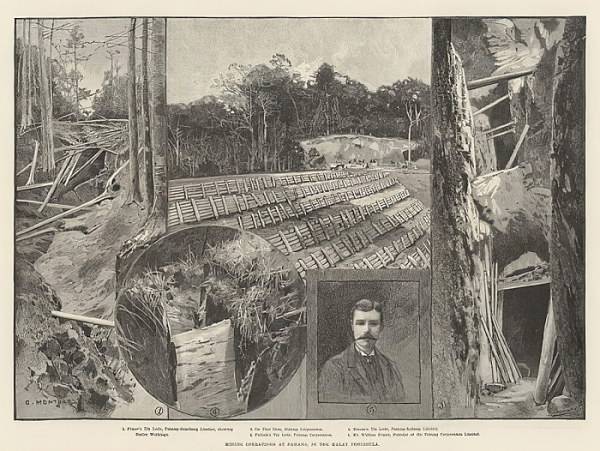
Mr. William Fraser dan lombong-lombong awal Pahang Corporation (1890): 1 (Kiri): “Fraser's Tin Lode, Pahang Semiliang Limited Native Workings”. 2 (Atas): “Thai Dam, Pahang Corporation”. 3 (Kanan): “Pollock's Tin Lode”. 4 (Bawah kiri): “Simons's Tin Lode, Pahang Kabang Limited”. 5 (Bawah kanan): “Mr William Fraser, Founder of the Pahang Corporation Limited”. (Charles Auguste Loye / George Montbard, 1890: |"Mining in Pahang, on the Malay Peninsula").
NOTA: Mr. William Fraser kemungkinan berasal dari Scotland, dan pernah menyumbang dalam percetakan sebuah buku puisi Gaelic: The cost of illustration (Dàin agus Orain Ghàidhlig, 1891) was defrayed by William Fraser of Pahang…” (Anne Loughran, 2018: |"Gaelic Literature of the Isle of Skye: an annotated bibliography").
1888-10: Perlantikan Residen British, J.P. Rodger
Syarikat Pahang Corporation Limited ini terus menjadi kepentingan utama pihak pentadbir British di Pahang. Mereka terus berusaha untuk mendapat persetujuan Sultan Ahmad bagi perlantikan residennya di Pahang, bagi memastikan kepentingan ini dapat terus dijaga dan dimanfaatkan. Usaha ini akhirnya berhasil pada Oktober 1888, dengan perlantikan J.P. Rodger sebagai Residen Pahang yang pertama: “Dalam bulan Oktober 1888 itu juga kerajaan British telah melantik seorang pegawainya bernama J.P. Rodger menjadi Residen British yang pertama di negeri Pahang. Tetapi pada hari bulan Julai 1889 baharulah ia datang ke Pahang memegang jawatannya itu. Sejarah mengenai Pahang yang telah ditulis oleh orang Barat berkenaan dengan kerajaan British meletakkan Residennya menggantikan wakil British di Pahang itu, terutama sebabnya yang telah dihebahkan oleh mereka ialah kerana pembunuhan yang telah berlaku terhadap seorang Cina rakyat British di negeri itu. Tetapi jika diperhatikan daripada kisah yang telah disebutkan di atas itu nyata sebabnya bukanlah kerana pembunuhan itu sahaja, melainkan terutamanya ialah kerana muslihat hendak memelihara kepentingan saudagar British yang telah menanam modal dalam syarikat yang menjalankan perusahaan melombong emas dan bijih timah di Pahang terutama syarikat British bernama Pahang Corporation Limited yang mendapat sokongan dari Pejabat Tanah Jajahan British di London.” (Haji Buyong bin Adil, 1972: |"Sejarah Pahang" (PDF), m.s. 276).
Peristiwa campurtangan secara lebih terperinci:-
“Perpindahan kuasa yang berlaku di Pekan iaitu daripada tangan raja Melayu (corak pemerintahan tradisional) kepada Inggeris sememangnya menimbulkan ketegangan. Menyedari kemungkinan berlakunya kemelut politik ini, terutama gejala kuasa pemerintahan baginda diatasi oleh Inggeris, Sultan Ahmad melantik putera sulung baginda Tengku Mahmud sebagai Tengku Mahkota di samping memberikannya kuasa sebagai wakil Sultan di Pekan, sementara baginda sendiri berundur kira-kira 200 batu ke ulu Sungai Pahang di suatu kawasan yang bernama Pulau Tawar dan membina istana di sana. Baginda dikatakan bersemayam di Pulau Tawar selama 3½ tahun (Disember 1889 hingga Mei 1893) dan meninggalkan bandar Pekan, ibu negeri Pahang, di bawah jagaan Tengku Mahmud.
Ada beberapa rentetan peristiwa yang membantu cepatnya campur tangan Inggeris di Pahang. Salah satunya ialah peristiwa pada suatu malam bulan Februari tahun 1888: seorang Cina yang berkedai di Pekan, Go Hui namanya, telah kena tikam tentang mulutnya pada suatu tempat berhampiran dengan istana Sultan Pahang. Hal ini telah heboh diketahui orang. Oleh sebab orang Cina yang kena tikam itu dikatakan seorang rakyat British di Singapura, maka Clifford telah masuk campur menyiasat siapakah yang telah menikam orang Cina itu. (Ada pendapat yang mengatakan Goh Hui bukannya rakyat British tetapi rakyat China, kerana dia datang terus dari negeri China). Bendahara Pahang iaitu Hakim Besar dalam negeri itu mengatakan pada perasaannya perbuatan itu ialah perbuatan hantu syaitan; tetapi Clifford tidak mahu percaya kepada cakap Bendahara itu. Dalam pada itu ada khabar angin mengatakan yang menikam Go Hui itu ialah seorang ketua hulubalang penjaga Sultan Pahang bernama Tuan Muda iaitu dengan titah Sultan Pahang kerana beginda telah jatuh berahi kepada isteri Go Hui itu yang bernama Ah Chu. Clifford telah meminta Sultan Pahang supaya baginda menawarkan hadiah kepada barang siapa yang dapat menangkap orang yang menikam itu. Oleh sebab permintaan Clifford itu, maka Sultan Pahang pun mengeluarkan surat titah menawarkan hadiah sebanyak seratus ringgit kepada barang siapa yang dapat membukakan rahsia itu. Tetapi surat itu tiadalah ditandatangani atau dicap dengan mohor baginda. Clifford telah berusaha hendak menyelesaikan hal itu. Ia bercadang menghantar Go Hui dan isterinya balik ke Singapura. Sultan Pahang mengatakan baginda tiada hendak menahan perbuatan Clifford itu, tetapi hendaklah Ah Chu itu terlebih dahulu menjelaskan hutangnya kepada baginda sebanyak $3,200.00. Dalam hal yang demikian, kira-kira pada bulan Mac tahun itu juga, Go Hui mati. Adapun ikhtiar Clifford (dan mungkin pihak yang terkemudian daripadanya) hendak mengetahui orang yang menikam Go Hui itu belumlah berhasil sehingga ke saat ini! Tiada berapa lama selepas itu iaitu pada 23 Jun 1888 Gabenur Negeri-Negeri Selat datang ke Pahang.”
(Sumber: Yaakub Isa, 17 Januari 2008: |"KUANTAN").
Sejurus selepas itu, A.H. Wall dilantik sebagai Pegawai Daerah Kuantan pada 1 Julai 1889: “Campurtangan Inggeris di dalam pentadbiran Negeri Pahang pada tahun 1888 telah memulakan era Sistem Residen. Melalui Sistem Residen, pentadbiran Negeri Pahang telah dibahagikan kepada beberapa daerah, antaranya ialah Daerah Kuantan. Daerah Kuantan telah ditadbirkan oleh seorang Pegawai Daerah. Pegawai Daerah yang Pertama dilantik pada 1 Julai 1889 ialah A.H.Wall. A.H.Wall mempunyai bidang kuasa yang luas dalam hal ehwal pembangunan tanah, percukaian dan kemasyarakatan. Di samping itu, terdapat banyak sistem pentadbiran negeri dan daerah di Negeri Pahang yang telah diberi nafas baharu melalui perubahan dasar-dasar pentadbiran oleh penjajah Inggeris. Antaranya ialah memperkenalkan sistem pentadbiran penguasa tempatan yang bertanggungjawab terhadap perkhidmatan bandar dan kesihatan kepada penduduk setempat.” (roshanilawatey, 29 Jun 2010: |"Sejarah Kuantan (3) : Pemodenan dan Perubahan Dasar Pentadbiran"). (Kemungkinan antara sumber asal: Alias Abdullah, Jabatan Perancang MPK dan Fauziah binti Zakaria, |"Pahang Dalam Sejarah, Bil.4, Tahun 1989", m.s.1: Sejarah Pembukaan Kuantan (1850-1970)).
1889-07-01: J.P. Rodger Mula Bertugas
“Pada 1 hari bulan Julai 1889, J.P. Rodger mula menjalankan tugas-tugasnya sebagai Residen British yang pertama di Paliang, dan tinggal di Pekan. Pada masa itu (tahun 1889) telah dilantik beberapa orang pegawai British memegang jawatan pentadbir dalam beberapa buah daerah di Pahang dengan gelaran Pemungut Cukai dan Majistret (Collector and Magistrate) yang berkuasa sebagai pegawai daerah pada masa ini, dan mereka jugalah yang menguasai pasukan polis di daerah masing-masing. Pegawai British yang pertama memegang jawatan pentadbir di Pahang itu ialah F. Belfield di Pekan, W.W. Michell di Kuala Pahang, A.H. Wall di Kuantan, E.A. Wise di Temerloh, dan W.C. Michell di Pahang. Pada masa itu Hugh Clifford yang telah diangkat menjadi Penguasa di Hulu Pahang (Superintendent of Hulu Pahang) telah pergi bercuti, dan jawatannya dipegang oleh W.C. Michell. Pegawai British itu telah diarahkan oleh kerajaan British supaya berikhtiar mendapatkan kerjasama orang-orang besar Pahang bagi menjalankan pentadbiran di daerah masing-masing.” (Haji Buyong bin Adil, 1972: |"Sejarah Pahang" (PDF), m.s. 280).
1889-07-22: Tengku Mahmud menjadi Pemangku Raja
“Pada 22 hari bulan Julai 1889 itu juga Sultan Ahmad telah mengangkat dan melantik putera sulung baginda Tengku Mahmud menjadi Pemangku Raja bagi negeri Pahang, kerana usia baginda telah bertambah lanjut dan telah merasa uzur hendak menjalankan tugas yang berhubung dengan pentadbiran pemerintahan. Baginda telah menyerahkan segala urusan pemerintahan negeri Pahang kepada Tengku Mahmud dan beliaulah juga yang akan menjalankan rundingan dengan Residen British Pahang bagi mengadakan undang-undang dan menjalankan peraturan dalam negeri, dan baginda telah menyatakan juga kepada semua orang besar dan ketua dalam negeri Pahang supaya mentaati perintah anakanda baginda itu seperti kepada baginda juga.” (Haji Buyong bin Adil, 1972: |"Sejarah Pahang" (PDF), m.s. 283-284).
1889-12: Sultan Ahmad Berpindah ke Pulau Tawar
“Di dalam bulan Disember 1889, Sultan Ahmad yang bersemayam di Pekan telah berangkat pindah bersemayam di istana baginda di Pulau Tawar, dalam daerah tempat kediaman Tok Gajah, tempat itu jauhnya hampir seratus dua puluh batu ke hulu dari Kuala Pahang. Pada tahun hadapannya, tahun 1890, baginda tidak pernah berangkat datang ke Pekan. Jika ada urusan negeri yang hendak dirundingkan dengan baginda, terpaksalah dibawa ke Pulau Tawar.” (Haji Buyong bin Adil, 1972: |"Sejarah Pahang" (PDF), m.s. 287).
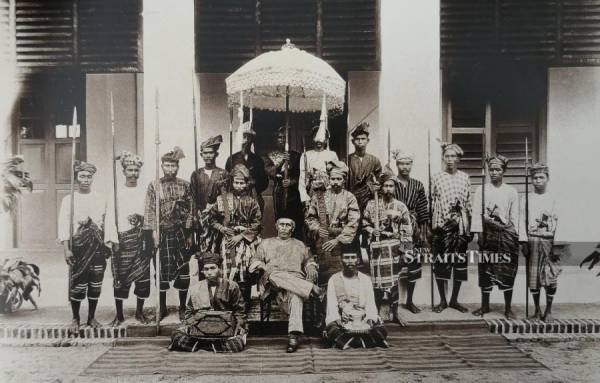
“Sultan Ahmad and his entourage in 1897.” (Alan Teh Leam Seng @ New Straits Times, May 5, 2019: |"Tracing Pahang's three capitals").
1889-1893: Peringkat Awal Perlombongan di bawah British
Pada peringkat awal kegiatan perlombongan ini, pelbagai kesukaran dialami, namun setelah kemudahan perkhidmatan pengangkutan dan hospital dibangunkan oleh pihak syarikat, dari kawasan perlombongan di Sungai Lembing sehingga ke muara Sungai Kuantan, keadaan menjadi beransur baik: “The difficulties of those early years, which were successfully overcome, were mostly of a physical character. The almost complete isolation of Sungei Lembing was the first challenge to be met. Although the area had been surface worked in a primitive manner for more than 100 years by the Malays and Chinese, without the use of explosives and only by an open cast system of mining, the territory was still virtually jungle-locked without roads or railways, and was quite inaccessible except by river from the port of Kuantan, 40 miles away. Kuantan, 200 miles by sea from Singapore, was itself isolated. There were no ships regularly sailing to Kuantan. In uncharted waters, navigation and entry into the mouths of the rivers on the east coast of Malaya, were always hazardous, and during the north-east monsoon season often four months would elapse without supplies inwards being landed at Kuantan from Singapore, or the Corporation's output of tin being shipped away to Singapore. At one time the then agents of the Corporation in Singapore, Messrs. Paterson, Simons & Co., had to charter a vessel, the Pilot Fish, to serve Kuantan, whilst a little later Mr. Neild had to purchase a steamer, the S.S. Perse, in an endeavour to ensure that a ship would call at Kuantan regularly twice a month; once, recourse was made to the use of native sailing craft. Wharves, warehouses and associated facilities, including a hospital, had to be built and provided almost immediately at Kuantan by the Corporation, and it is true to say that Kuantan owed its existence to the Corporation's activities and enterprise in Pahang in those early years. … There were no government hospitals in Sungei Lembing and Kuantan in 1890, and it was therefore expedient for the Corporation, at its own expense, to build a hospital in each of the two towns, both of which were then maintained and run by the Corporation and its medical officers. These institutions dealt not only with the European staff and labour force of the Corporation over the years, but they also succoured and cared for all and sundry, including Government Police, P.W.D. personnel, and others who needed medical attention in the Kuantan and Sungei Lembing districts.” (Pahang Consolidated Company, 1966: |"Sixty Years of Tin Mining: A History of The Pahang Consolidated Company - 1906-1966: I. The Pioneering Years - The Pahang Corporation" (PDF), m.s. 16, 18).
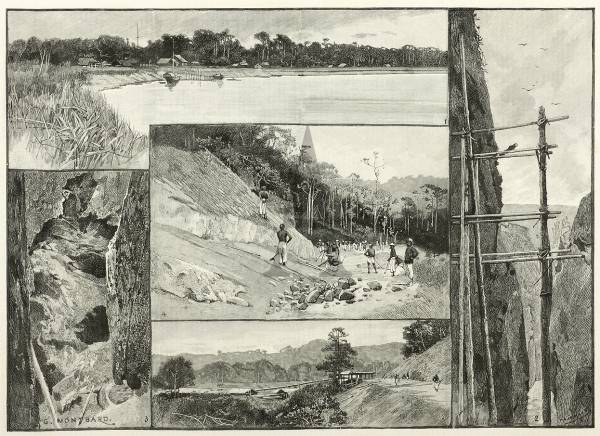
Operasi perlombongan di Pahang (1890): 1 (Atas): “Kuala Rumpen (Rompin) Pahang” 2 (Kanan): “Nicholson’s Tin Lode, Pahang Corporation.” 3 (Kiri): “Smyth’s Tin Lode, Pahang-Kabang Limited.” 4 (Tengah): “Chinese constructing Tramway and Water-race, Pahang Corporation.” 5 (Bawah): “Tin Stamping Mill, Pahang Corporation.” (G.Montbard, 1890: |"Mining Operations at Pahang, in the Malay Peninsula").
Pelabuhan utama syarikat ini terletak di kuala Sungai Kuantan, ketika itu Kampung Kuantan. Di sini, setiap hasil bijih timah yang dibawa dari hulu sungai sejauh 40 kilometer, akan diturunkan di sini, dan seterusnya dipersiapkan untuk dibawa ke Singapura:-
“Kuantan is the most northerly of the Pahang river districts, and it has one of the nastiest bars, upon which the waves break with extraordinary fury except in the calmest weather. It is distant from Singapore about 240 miles, say a day's journey. Bold hills guard the northern bank of the river, and somewhat mitigate the severity of the monsoon weather within the Kuala. Once inside, a deep winding river, navigable for ships of light draught for many miles, forms an excellent harbour. On the left bank stands the Pahang Corporation wharf, a large godown, and several houses and bangsals also belonging to the Company. The official village of Kuala Kuantan consists of a police-station, court-house and the Magistrate's bungalow. The commerce of the place is housed in a row of attap erections. The Government has also a wharf, a busy place, the resort of native boats to the number of perhaps half a dozen per month. But then natives have prejudices with regard to policemen and government officials, from their invariable assocation with taxation. The elaborate system of passes, licenses, and fees in Pahang seems to make that prejudice not unfounded.
Kuala Kuantan is the port of the P.C., Ltd. There all stores are received, housed, and despatched upstream in flat bottomed boats. All tin-ore down stream is here landed, checked, and shipped. The Agent of the Corporation, and the Magistrate, hold about equal sway, the balance of power lying possibly with the former, since with him is the hope of the rich reward that sweetens the not too exhausting labours of the Malays of the river. Without the Corporation's Agent and the money he disburses for wood-cutting, cargo working, and boat hire up and down the river, Kuala Kuantan would be a mere fishing village, for although Tringganu men come and build marvellously solid boats of a hard wood called chinghal, the men of Kuantan are content to go to sea in fine weather and catch a few fish. Fish and large families foregather in Kuantan.”
(Sumber: The Singapore Free Press and Mercantile Advertiser, 27 October 1897 & Weekly @ 2 November 1897: |"THE PAHANG CORPORATION, Ltd.").

Kampung Kuantan @ Kuala Sungai Kuantan (1890): “C19th engraving of Malaysian tin mines. Inset titles:
1. Entrance to the Kuantan River, where the Pahang Corporation are working.
2. Batu Sawah, the landing-stage sixteen miles up the Kuantan.
3. Campbell's Tin Lode (Pahang Corporation). Showing ancient workings.
4. Sungei Lambing District, where the Pahang Corporation are working their mines.
5. Native Chinese Tin-Stamping Mill, on the Kuantan.
From the original edition of the Illustrated London News.” (G. Monetbard, 1890: |"Mining Operations in the Malay Peninsula").
Pada tahun 1893, denai sepanjang 12 batu telah diterokai merentasi hutan dari Sungai Lembing ke Kuala Reman (kira-kira separuh jalan ke Kuantan). Setelah itu, masa perjalanan di antara Sungai Lembing ke Kuantan dapat dipendekkan (asalnya 2-15 hari, mengikut keadaan paras air sungai): “By 1893, a track through the jungle was cut from Sungei Lembing to Kuala Reman, a point about 12 miles down stream. A specially designed shallow draught stern-wheeler sent out from England was then able to get up the river as far as Kuala Reman, and the journey from Kuantan to Sungei Lembing, which on one occasion took 15 days and rarely less than two, was appreciably shortened. Even so, for years after, the journey by river was unreliable, since it was so often either in flood during the monsoon season or, in the dry season, there was insufficient water in its upper reaches, and in quite recent times the river was not navigable above Pasir Kemudi.” (Pahang Consolidated Company, 1966: |"Sixty Years of Tin Mining: A History of The Pahang Consolidated Company - 1906-1966: I. The Pioneering Years - The Pahang Corporation" (PDF), m.s. 16).
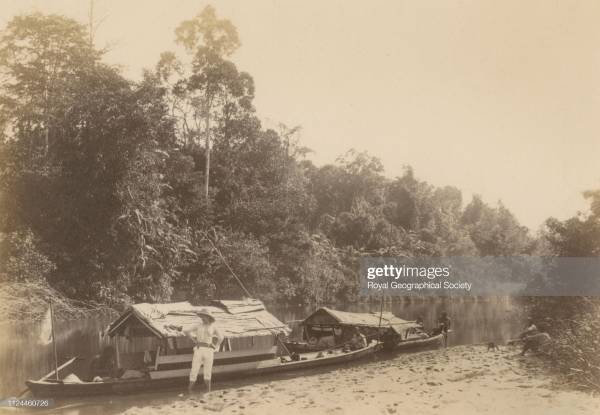
“A stop on the Kuantan river for breakfast, Malaysia, 1894. Artist H.M. Becher.” (Royal Geographical Society via Getty Images, 01 January, 1894: |"A stop on the Kuantan river for breakfast").
Pemberontakan Dato' Bahaman, bersama Tok Gajah dan Mat Kilau mulai akhir tahun 1891 menambahkan lagi cabaran kepada pengusaha lombong. Pada akhir tahun 1893 hasil perlombongan di Pahang didapati masih belum memuaskan. Kesannya, Residen British membatalkan banyak konsesi perlombongan di Pahang, dan tiada pelaburan baru di sektor ini untuk tahun 1894. Pada tahun 1895, hanya lombong-lombong lod sedia ada sahaja (termasuk Pahang Corporation) yang masih aktif:-
“Many of the concessions, obtained as speculations, were never prospected. Others were prospected in a desultory manner by European companies which turned their attention elsewhere without starting serious mining operations. At the end of 1893 some twenty of these unworked concessions were cancelled. Most of the other concessions were under some form of European ownership or control. Concessions with alluvial tin deposits were the first to be brought into production (fig. 19). Since the equipment needed was not elaborate, and the scale of mining could be varied to suit the labour force available, companies at Bentong, Sungei Dua, and Belat, the latter near present day Gambang, began work as soon as their indentured Chinese labourers arrived from Singapore. Tin was being exported within twelve months but the obstacles quickly became apparent. Living as they were in freshly made clearings, management and labourers alike suffered from malaria and the mortality rates were very high. Direct supervision of inexperienced Chinese labourers by European managers, who also lacked experience, was not a success and differences which arose were aggravated by ill health and isolation. In 1890 serious work ceased at Sungei Dua and Belat and the companies involved transferred the remnants of their labour forces to lode mining properties. The Bentong Company exported “a considerable amount” of tin ore in 1890 but was unable to recommence work after a stoppage caused by the rebellion of the local chief at the end of 1891. … It was clear that Chinese mining, with its more flexible organisation and lower overhead costs, would be better able to exploit these alluvial deposits.” (Dr. R.G. Cant, 1973: |"An Historical Geography of Pahang" (PDF), m.s.44).
“Lode mines could not be developed rapidly. More substantial buildings were required and the task of importing crushing and pumping equipment was a difficult one in a land where rivers and jungle paths were the only lines of communication. In each case heavy equipment was taken inland by river and then dragged overland from river landing places to the mines (fig. 1 g). Some of the machinery intended for mines at Selinsing was taken up the Pahang and Jelai Rivers to Kuala Medang but never reached the site of the workings. Another company at Ulu Kuantan attempted to avoid such problems by locating its plant at Baias on the Kuantan River. By the end of 1891 this company had erected elaborate crushing equipment, complete with an eight head stamp, dressing floor and wells, in addition to building a tramway, numerous bungalows for European staff, and a substantial hospital. All that was lacking, commented the writer of the Pahang Annual Report for that year, was a lode of tin in the vicinity of the mill which would repay the cost of working.” (Dr. R.G. Cant, 1973: |"An Historical Geography of Pahang" (PDF), m.s. 46).
“By the end of 1893 the records make it clear that there were only four European mining companies engaged in serious work in Pahang. There were the three companies mining gold at Raub, Penjom and Selinsing, and the Pahang Corporation working the tin lodes at Sungei Lembing. Although some minerals were being produced (figs. 20 and 21), output bore no relation to capital expended and it was as yet too early to assess the eventual profitability of such mines. It was very clear, however, that European mining in Pahang had not been established on the scale envisaged by the optimists of the 1880's. European attempts to mine alluvial tin had failed and the more successful ventures of men like L.J. Fraser were the result of entrepreneurial rather than mining skill. With only four companies in operation, and approximately one thousand labourers employed, European mining had been established on only a modest scale and it remained to be seen whether these ventures could survive on a permanent basis. In view of the considerable capital expenditure and the high ratio of European staff it was clear that a considerable output of minerals, and a marked reduction in overhead costs, would be required if the companies were to continue in operation. At the end of 1893 the British Resident cancelled some twenty of the concessions and noted in his report that “Government now has at its disposal large areas of mining and agricultural land”. There was, however, no influx of new capital or population into Pahang in 1894. The first flush of optimism was over and neither Europeans nor Chinese were attracted by the new image which was emerging. Europeans were unwilling to introduce new capital until the existing ventures had proved themselves to be economically sound and the Chinese were too busily engaged in the western States where communications were well developed, overhead expenses considerably lower, and returns more assured. In 1895 it was officially recognised that apart from the activities of the lode mines, mining development in Pahang was at a standstill. The mining policy initiated by Rodger in 1889, and carried on by his successors, was administratively sound but its long term consequences were unfortunate. The effective opening up of Pahang was delayed at a critical time when the western States had already entered a phase of sustained and cumulative economic development. In Selangor, Perak, and Negri Sembilan, economic opportunities were expanding faster than the tin reserves were diminishing and Pahang lost much of its attractiveness in consequence. During these first four years the new economic penetration of road less Pahang was made with comparatively slender private resources. Small European mining ventures were unable to make that initial conquest of the forest environment necessary to overcome a high level of endemic disease. Chinese syndicates which could more readily have come to terms with the environment were largely excluded. Larger European enterprises were too few, and communications too meagre, to produce external economies which might reduce their overhead costs. Their total investment was not inconsiderable but in the absence of parallel investment in the public sector any immediately cumulative effects were lost in the vastness of this sparsely settled State.” (Dr. R.G. Cant, 1973: |"An Historical Geography of Pahang" (PDF), m.s. 45-47).
1888-1891: Peningkatan Populasi Warga Tionghua
Seiring dengan perkembangan perlombongan ini, populasi warga Tionghua di Pahang kembali meningkat:-

“Table 2. The Population of Pahang 1888”
“The majority of the 3,241 Chinese enumerated in the 1891 census would have entered Pahang after the beginning of British rule and the introduction of regular steamship services from Singapore to Kuala Pahang and Kuantan. The total in 1888 was certainly not greater than Rodger's estimate of 1,500. Most of the Chinese were found in the town of Pekan where there was a Chinese quarter, the trading village of Penjom, and in the mining areas in Ulu Pahang and Ulu Kuantan. During the drier period of the year, from March to November, small groups of Chinese engaged in timber extraction could be found in areas which were easily accessible from the coast and not permanently inhabited by Malays. The Pahang River was regularly used by Chinese traders, and Swettenham in 1885 had noticed a number of small Chinese sugar mills on the left bank of the Pahang River between Pulau Tawar and Temerloh. Chinese traders had been living among the Malays in the Tembeling Valley when Mikluho-Maclay passed through there in 1875 but there is good reason to believe that the existence of individual Chinese among the Malays in such remote areas could have only been temporary in the decade that followed. By 1888 the Chinese population which survived in Pahang had concentrated itself into a few mining areas and trading centres in an effort to achieve greater security.”
(Sumber: Dr. R.G. Cant, 1973: |"An Historical Geography of Pahang" (PDF), m.s.31).
1890-an: Kegiatan Perikanan
“Fishing in Pahang was either a part time occupation or an inadequate source of income. The present expansion of coastal fishing in Pahang dates from the year 1891. In July of the previous year, at a time ideal for fishing, the Kuantan District Officer visited the coastal areas between Kuantan and the Trengganu border but found almost no fishing activity. He did, however, meet some Malays who informed him that beyond the State boundary there were those who would come and settle “for a little money”. The District Officer was unable to oblige in this respect but he must have generated some confidence for they came nevertheless. At the end of 1891 he reported that “the fishing
industry, carried on principally by Trengganu Malays who have settled along the coast, is increasing rapidly and I hope that by encouraging settlers at the mouths of some of the small coast rivers, all of which are scantily populated, permanent villages and plantations may gradually spring up”.
In 1894 the Kuantan District Officer compiled a detailed report on the fishing industry in Pahang. This report is significant not only for the descriptive and statistical material which it contained, but also for the policy which
it formulated at that date.
According to the report there were well over 300 boats of various kinds operating from the Pahang Coast in 1894 (Table 3). Some 48 of these were boats exceeding 30 feet in length, and 20 of the boats based at Kuala Pahang
were jalaks which could venture out to sea in moderately rough weather. The majority of the fishermen employed were of “the lowest class of Kelantan and Trengganu Malays” who either “return to their homes at the end of the season”
or, being without employment during the north-east monsoon, “relapse into petty theft or more serious offenses relating to property”. The writer further commented that the reason always given by newcomers arriving from Trengganu or Kelantan was that “their former headman has recently removed from that district”. There is also evidence that a number of Chinese fish merchants from Trengganu moved to settle in Pahang at this stage and their activities are reflected in a steady increase in exports of dried fish. Immigrant Malay labour, Chinese entrepreneurship and the security of British rule thus appear to be the three main factors in this re-establishment of the Pahang fishing industry. Much remained to be done, however, before the economy of the coastal fishing settlements was placed on a satisfactory footing. The author of the report realised the advantages of permanent settlement and the need for supplementary sources of income. He thus recommended that the fishermen be given free grants of land for planting and rice cultivation.”
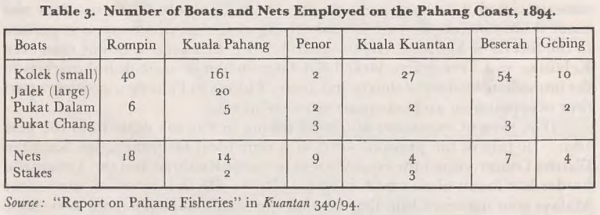
“Number of Boats and Nets Employed on the Pahang Coast, 1894”.
“The administration adopted this policy but for various reasons the results were not satisfactory. In the first place rice cultivation was held in no higher regard by the fishing population than by the local Malays in the coastal districts. Even more serious was the fact that the months for the preparation and planting of coastal padi coincided with the best fishing months. In addition, the administration retained all the land which might be required for commercial purposes and limited their special grants to the sandy and infertile land immediately adjacent to the coast. A number of plots were taken up in 1895, chiefly between Beserah and Batu Hitam, but over 30 percent of the trees planted were blown over or washed out the following year. Matters were not improved when the administration decided to charge quit rents on land alienated to fishermen settlers and in 1898 a number of settlers left Pahang and moved into Trengganu because they were required to pay quit rent for one of the few areas which had been taken up for coastal padi. In spite of these and similar frustrations, the fishing population continued to increase during the next decade and more settlements were established at various points along the coast. Some planted coconut trees but none were willing to persevere regularly with wet padi. To this day the fishing settlements of Pahang have an inadequate agricultural base and the standard ofliving there is the lowest in Malaya.”
(Sumber: Dr. R.G. Cant, 1973: |"An Historical Geography of Pahang" (PDF), m.s. 59-60).
LATAR LOKASI: Beserah
1890-an: Kegiatan Pertanian
“In the first four years of British administration a few of the concession holders made desultory attempts to explore the agricultural potential of their lands. The Pahang Corporation, who initially held rights over the watersheds of the Kuantan, Rompin and Endau Rivers, did this more seriously than most. Their agent, A.J.G. Swinney, spent most of 1889 and 1890 exploring the Rompin River and reported favourably on its possibilities. No minerals were found, however, and the Corporation decided to confine its activities to the Kuantan District. There they made experimental plantings of tobacco, pepper, and coffee, and imported plants of nutmeg and pepper which they distributed to Malays who were encouraged to grow them on special grants of Corporation land. In most cases the plants grew well but both the Corporation and the Malays were too preoccupied with other activities to persist
with cultivation.
…
In 1898 a party of Malacca Chinese arrived at Kuantan in search of new land for tapioca and the following year they were permitted to open up two estates on hilly land which the District Officer described as too sandy and useless for any other purpose. About the same time some of the European and Chinese entrepreneurs already resident in Pahang took up land in the vicinity of Kuala Kuantan and Kuala Pahang. By the turn of the century they had established four coconut estates, each of several hundred acres. Commercial agriculture was established but on a very modest scales.”
(Sumber: Dr. R.G. Cant, 1973: |"An Historical Geography of Pahang" (PDF), m.s. 62-63).
Peta Kuantan 1891
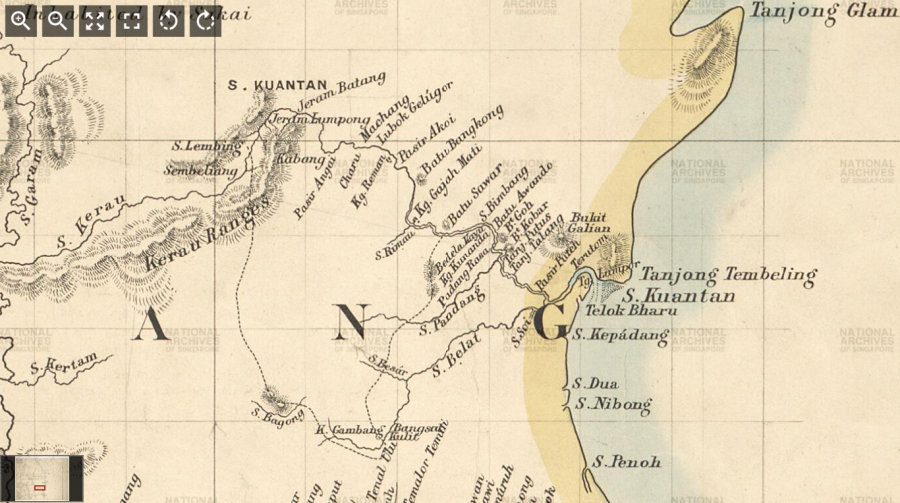
Peta Kuantan 1891: “Map covers part of eastern Malaya showing Trengganu, part of Kelantan, part of Pahang, coastline fronting (South) China Sea, islands, approximate state boundaries, tracks, place names, kampongs, rivers, streams, hill hachures, locations with tin or gold, “tin countries”, Penjum with gold location, Gold Company at Raub, (London) Pahang Syndicate at a gold location, (Kuala) Trengganu, Pekan, Kota Glanggi (limestone caves), Gonong Tahan, Sungei Kuantan, Sungei Pahang, Sungei Jalai (Jelai), Sungei Tembeling, Sungei Telang, Sungei Lipis, Sungei Semantan, Sungei Bilut, Sungei Bentong, Sungei Kelantan, descriptions “Uninhabited (except by Jakuns)”, “Inhabited by Sakai & Semang”, “All the country above the S. Tembeling and west of the Pahang and Jelei Rivers from above Triang first explored by William Cameron, 1882” and others.” (Royal Geographical Society, London, 1891: |"Map Of The Malay Peninsula 1891").
1891-1894: Pemberontakan Datuk Bahaman bersama Tok Gajah dan Mat Kilau
Ramai pihak tidak senang dengan perlantikan wakil (kemudiannya Residen) British di Pahang, terutamanya Datuk Bahaman (Orang Kaya Semantan). Keadaan ini mencapai kemuncaknya apabila Tengku Mahmud (pemangku Sultan Ahmad) menghadkan bayaran gaji kepada pembesar-pembesarnya, di atas nasihat pemangku Residen, Hugh Clifford. Berikutan itu, Beberapa pemberontakan menentang British di serata negeri Pahang, diketuai oleh Dato' Bahaman dan para pengikutnya: Tok Gajah, Mat Kilau, dan Mat Kelubi. (Haji Buyong bin Adil, 1972: |"Sejarah Pahang" (PDF), m.s. 297-351).
Sumber lain: “Mining in Pahang had languished since the 1850s but the reputation of the state as one of unbounded riches remained. Here the sultan continued to exercise effective authority and decided to take advantage of the gold fever of the early 1880s to grant extensive concessions. One of these covered tin deposits which had already been proved by Chinese and Malay miners and in 1886 it was acquired by London interests who floated it as Pahang Mining Company. A Cornish mining expert provided a very favourable and honest report which would see the property developed as a large lode mine. This would require a more secure title, one that only a British administration could provide and in 1888 the sultan agreed to accept a British Resident. That prompted a rebellion on the part of some Malay chiefs which required British support to subdue.” (John Hillman, 2010: |"The International Tin Cartel" (PDF), m.s.34).
Pencetus pemberontakan bersenjata: tindakan C.E.M. Desborough: “Pada 15 hari bulan Disember 1891 itu, C.E.M. Desborough yang menjadi Pemangku Pemungut Cukai Tanah di Mukim Semantan serta seorang inspektor lombong yang membawa lima belas orang mata-mata bangsa Sikh dan enam orang matamata Melayu, telah mudik di Sungai Semantan pergi ke Lubuk Terua untuk menambahkan bilangan mata-mata di balai polis di situ. Semasa dalam perjalanan Desborough telah berjumpa dan menangkap tiga orang pengikut Datuk Bahaman yang telah dituduh mengeluarkan hasil hutan dengan tidak mempunyai surat kebenaran daripada kerajaan. Desborough tidak mahu melepaskan mereka walaupun kaum keluarga mereka mahu menjamin, mereka telah dibawa ke balai polis Lubuk Terua ditahan untuk dibicarakan. Oleh sebab Datuk Bahaman memikirkan pasukan British yang datang itu telah dirancang untuk menangkapnya, beliau telah bersedia menghimpunkan pengikutnya. Pada hari yang kedua, pasukan Desborough telah diserang hendap oleh orang-orang Datuk Bahaman dan berlakulah pertempuran. Beberapa buah perahu pihak British telah ditenggelamkan oleh orang-orang Datuk Bahaman, inspektor lombong itu serta seorang Melayu pengayuh perahu dan seorang mata mata Sikh telah luka. Oleh sebab tidak dapat menentang serangan itu, Desborough dan mata-mata Sikh yang dibawanya itu telah lari semula ke Temerloh dengan menggunakan beberapa buah perahu yang ada pada mereka. … Setelah berjaya menyerang dan mengalahkan pasukan Desborough itu, Datuk Bahaman dan pengikutnya telah pergi menyerang dan menawan balai polis di Lubuk Terua. Kemudian mereka menyerang dan berjaya menawan rumah stor kepunyaan syarikat lombong di Raub dan di Bentong dan mengambil makanan dan barang yang tersimpan di situ. Pada masa itu Datuk Bahaman telah terus terang menyatakan maksudnya hendak menentang pihak British yang menjalankan pemerintahan di negeri Pahang dengan menggunakan senjata. Kejayaan Datuk Bahaman mengalahkan pasukan Desborough di Sungai Semantan itu telah membangkitkan semangat berani orang-orang Melayu di Semantan menentang British, dan telah mengambil ramai lagi orang Semantan menjadi pengikutnya. … Tiada lama kemudian, angkatan Datuk Bahaman telah menyerang pekan Temerloh. Desborough dan mata-mata yang mengawal tempat itu telah lari meninggalkan pekan Temerloh. … Pada masa itu Datuk Bahaman dan pengikutnya telah berjaya menguasai daerah di Sungai Semantan hingga ke Temerloh.” (Haji Buyong bin Adil, 1972: |"Sejarah Pahang" (PDF),m.s. 302-304).
Pemberontakan berakhir dengan kekalahan pihak Datuk Bahaman di Jeram Ampai pada 29 Jun 1894: “Pada pagi 29 hari bulan Jun 1894, pasukan besar pihak British dari Kuala Tembeling telah bergerak hendak menyerang pasukan Tok Gajah, Tok Bahaman dan Mat Kilau di Jeram Ampai. … Tiada lama bertempur, pihak Tok Gajah dan sekutunya itu dapat menahan tembakan dari pihak British itu, lalu Tok Gajah, Tok Bahaman, Mat Kilau dan pengikut mereka berundur meninggalkan kubu mereka di Jeram Ampai mudik ke hulu Sungai Tembeling ke Hulu Lebir (Kuala Ampul) di Hulu Kelantan. … Dari pihak orang Melayu yang menentang pihak British itu pula mengatakan kekalahan di Jeram Ampai ialah kerana orang-orang Pahang telah belot kepada mereka dan telah menolong orang putih. … Walaupun serangan pihak British di Jeram Ampai itu telah dilancarkan dengan pimpinan yang kurang baik, tetapi sejak itu boleh dikatakan tamatlah pertempuran di negeri Pahang yang dibangkitkan oleh orang Melayu yang menentang pihak British yang telah mencampuri pemerintahan di negeri Pahang itu, kerana pemimpin mereka itu telah berundur ke negeri Kelantan dan Terengganu.” (Haji Buyong bin Adil, 1972: |"Sejarah Pahang" (PDF),m.s. 350-351).
1895-06-12: Perjanjian Persekutuan
Di dalam Perjanjian Persekutuan pada 12 Jun 1895, Negeri Perak, Selangor, Negeri Sembilan dan Pahang disatukan menjadi Negeri-Negeri Melayu Bersekutu. Antara punca Pahang turut serta di dalam persekutuan ini ialah masalah kewangan berikutan pemberontakan sebelumnya, serta kekangan-kekangan di dalam kegiatan perlombongannya, yang dapat diselesaikan dengan penggabungan ini. (Pahang Consolidated Company, 1966: |"Sixty Years of Tin Mining: A History of The Pahang Consolidated Company - 1906-1966: I. The Pioneering Years - The Pahang Corporation" (PDF), m.s. 12).
“It is against the background of growing European mining interests that the final moves towards consolidating British rule over the whole peninsula were made. A confederacy of several autonomous states, including Sungei Ujong, was constructed as Negri Sembilan and made part of the Residency system. Repression of the Pahang rebellion had left that state bankrupt and in 1895 its sultan, together those of Negri Sembilan, Selangor and Perak,signed a Treaty of Federation and the Federated Malay States (FMS) was brought into being.” (John Hillman, 2010: |"The International Tin Cartel" (PDF), m.s.35-36).
Setelah Pahang berada di bawah naungan British, Sultan Pahang membatalkan sebahagian daripada konsesi yang telah dianugerahkan kepada Pahang Corporation pada tahun 1888, iaitu terhad kepada bahagian daerah Kuantan selepas Kuala Reman. “The initial selection of Mr. Neild and his appointment in 1890 had been influenced by the British Resident in Pahang who, in his Annual Report for 1889, had expressed the view that: ” … it is more important that an Eastern Mining Manager, who must necesarily be entrusted with very wide powers by the Director of his Company, should be a capable man of business, accustomed to life in the East, than that he should possess the practical mining experience which can be readily supplied by his subordinates …. “ There is no doubt that it was these views, and the success of Mr. Neild, which influenced the Directors of the Corporation to choose as his successor a clerk who had already been some years in their employ. He was Mr. W. H. Derrick and he succeeded Mr. Neild as Superintendent in 1895 and held this responsible position for ten years to 1905. Less than a year after the appointment of Mr. Derrick, difficulties again arose over the Corporation's Concession. It was the year after the State of Pahang became one of the protected Malay States to be administered under the advice of the British Government. Suddenly the Sultan of Pahang, acting under the control of the State's Government, cancelled from the Corporation's 1888 Concession, the outlying portion of the territory belonging to the Corporation, and its rights were restricted to that part of the Kuantan district above Kuala Reman.” (Pahang Consolidated Company, 1966: |"Sixty Years of Tin Mining: A History of The Pahang Consolidated Company - 1906-1966: I. The Pioneering Years - The Pahang Corporation" (PDF), m.s. 14).
Pada tahun yang sama, pembangunan jaringan perhubungan dan pengangkutan di antara Perak, Selangor, dan Pahang bermula dengan pesatnya, antaranya jalan Kuala Kubu - Kuala Lipis (1895-1896), yang menggalakkan penghijrahan tenaga pekerja dari pantai barat ke sepanjang jalan tersebut, termasuk pembukaan beberapa lombong kecil di Raub dan Tras. Pada tahun 1897, pengusaha lombong terkenal di Selangor, Loke Yew, dianugerahi sebuah konsesi seluas 4,000 ekar di Bentong. Perlombongan besar-besaran di situ beroperasi setahun selepasnya, bersama dengan pertumbuhan bandar-bandar baru serta jaringan jalan raya, termasuk Bentong-Tranum-Tras. (Dr. R.G. Cant, 1973: |"An Historical Geography of Pahang" (PDF), m.s. 48-49).
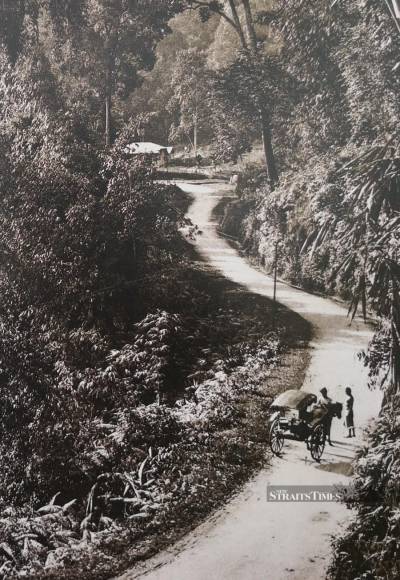
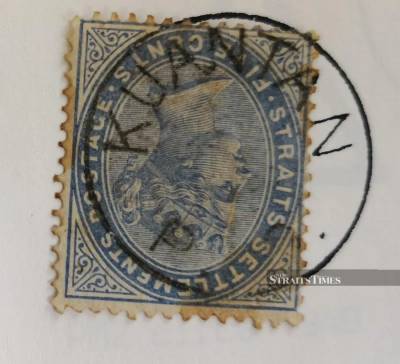
Kiri: “Road from Kuala Lipis to Raub in the 1890s.”
Kanan: “Straits Settlements stamps bearing Kuantan postmarks from the 1890s are very rare.”
(Sumber: Alan Teh Leam Seng @ New Straits Times, May 5, 2019: |"Tracing Pahang's three capitals").
1897-1900: Kegemilangan Pahang Corporation
Sementara itu di Ulu Kuantan (Sungai Lembing dan sekitarnya), keadaan operasi dan kewangan Pahang Corporation tampaknya agak baik ketika ini. Seorang wartawan The Singapore Press dari Singapura telah melaporkan lawatannya ke ibu pejabat syarikat ini di Sungai Lembing, dan telah memberi gambaran yang amat positif tentangnya (The Singapore Free Press and Mercantile Advertiser, 27 October 1897 & Weekly @ 2 November 1897: |"THE PAHANG CORPORATION, Ltd.").
Namun oleh kerana kedudukannya yang terpisah dengan pusat pentadbiran British di sebelah barat, ianya agak terabai oleh pihak kerajaan. Namun pihak syarikat masih berupaya memajukan kawasan tersebut: “Lode mining for tin was, during this period, confined to the Pahang Corporation's concession in the Ulu Kuantan. During the 1890's the three European companies at work there were the only producers in the Kuantan District and their aggregate output exceeded that or all other tin mines in the State (figs. 21 and 22 ). Even so, they were working under difficulties and one or the subsidiary companies was forced to recombine with the parent company. The Corporation made numerous requests for government help in improving access to the mines and to the large settlement which had grown up at Sungei Lembing but, in spite or the large contribution the mines were making to State revenue, the administration was prepared to give no such help. Revenue, was, in effect, diverted from the Kuantan District and expended in the western interior of the State. (In 1896, for example, the administration refused a request for a four mile road from Baias to Sungei Lembing (Kuantan 208/96). In his report for the same year the Kuantan District Officer revealed that revenue in his district was six times greater than expenditure resulting in a surplus of over $20,000. “The revenue”, he commented, “was mainly from the 5 percent duty on Pahang Corporation tin”, and the expenditure “is kept as low as possible, and nothing can at present be done to open up the country either by roads, or improvements to the river navigation or existing tracks” (Kuantan 19/97). In 1898 the Kuantan revenue surplus was over $30,000 and in 1899 over $50,000 but still no road construction was commenced in the District. Meanwhile government had made a grant of $68,000 towards the building of Loke Yew's road at Bentong.) In spite of this, the Pahang Corporation completed its initial development work and appeared to have settled down to regular production by the turn or the century (fig. 21 ).” (Dr. R.G. Cant, 1973: |"An Historical Geography of Pahang" (PDF), m.s. 53).
Menjelang awal 1900-an, negeri-negeri Selat Tanah Melayu menghasilkan kira-kira 60 peratus bijih timah dunia. Perlombongan sebelum ini, terutamanya di pantai barat, adalah lombong terbuka (alluvial). Di Ulu Kuantan, kebanyakannya adalah lombong lod/telerang (lode mine), dan yang terbesar adalah rangkaian lombong-lombong lod syarikat Pahang Corporation (Willink's, Nicholson's, Bell's North, Bell's South, Pollocks, Jeram Batang) dan Pahang-Kabang (Bai(y)as). (W.T. Saunders, 1904: |"Transactions of The Institution of Mining Engineers, Vol. 27, 1903-1904": "Tin-mining in the Straits Settlements" (PDF))
Peta Kuantan 1898
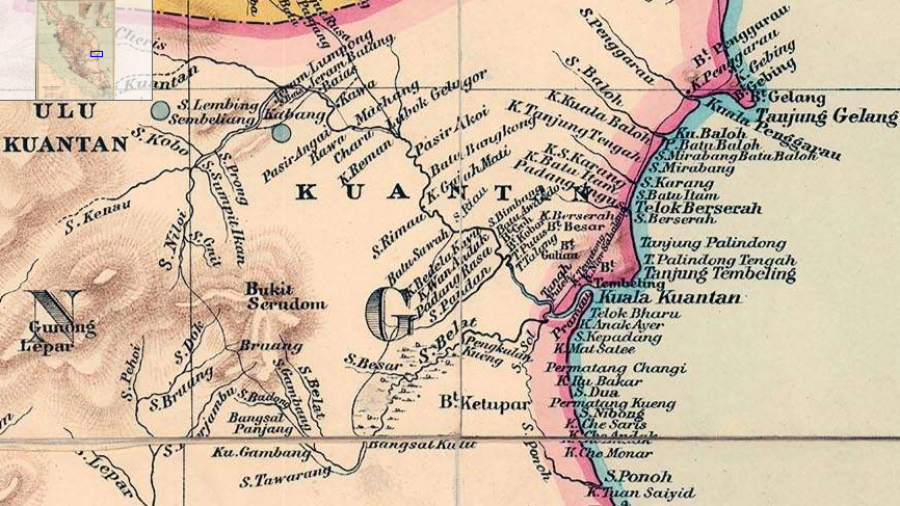
Peta Kuantan, 1898 (John van Cuylenburg, 1898 @ Geographicus: |"1898 Cuylenburg / Stanford Map of Malaya Peninsula: Malaysia, Singapore, Siam").
1900-1909: Kemerosotan Pahang Corporation, dan Kemunculan Loke Yew di Gambang
Pahang Corporation mula merosot pada awal 1900-an: “In the early years of the present century, however, production from the Pahang Corporation mines began to fall off and serious reassessments were made as to their future. Transport costs remained excessive and, in addition, the internal organisation of the companies was unsatisfactory.” (Dr. R.G. Cant, 1973: |"An Historical Geography of Pahang" (PDF), m.s. 53).
Perlombongan bijih timah di pantai barat (Selangor dan Perak), termasuk sebelah barat Pahang seperti Raub, Tras, dan Bentong, telah terbukti berjaya dan stabil lebih lama, lalu menggalakkan lebih banyak pelaburan. Operasi lombong alluvial (terbuka) di sana lebih mudah difahami oleh para pelabur dan pentadbir, berbanding lombong lod (lode mine) di Ulu Kuantan. Oleh itu pihak kerajaan Pahang telah mengalihkan fokusnya kepada Pahang barat, seterusnya menjadi salah satu faktor pemindahan pusat pentadbirannya dari Pekan (Pahang timur) ke Kuala Lipis (Pahang barat) pada tahun 1889. Ini menimbulkan banyak cabaran kepada pengurusan lombong di Ulu Kuantan. Selepas beberapa tahun, keadaan kewangan Pahang Corporation semakin meruncing, sehingga ada tahun 1904, antara anak syarikat utamanya, Pahang Kabang, telah berhenti beroperasi, diikuti Pahang Corporation pada tahun 1906.
Berlatarkan perkembangan ini, Loke Yew dianugerahi konsesi di kawasan Belat-Gambang / Ulu Lepar seluas 10,000 ekar pada tahun 1903. Sepertimana di Bentong (Pahang Barat) sebelum ini, beliau membangunkan lombong-lombong terbuka (alluvial) di sini dengan pesatnya. Kemerosotan Pahang Corporation di Sungai Lembing / Ulu Kuantan memberi kelebihan lagi kepada beliau:-
“The next important development took place in 1903 when the government granted Loke Yew a similar concession in the Belat-Gambang area, inland from Kuantan. In spite of the fact that this area was already being pioneered by two small syndicates - one Chinese and one European - other applications were held over for three years while Loke Yew's agent selected 10,000 acres of mining land. In 1904 Loke Yew opened up several large open-cast mines on the alluvial flats and by the end of that year over two thousand men were employed and the output of tin was increasing rapidly (fig. 23). During 1905 Loke Yew's activities increased as further leases were taken up and in 1906 a new impetus was received when the reopening of the field to other miners coincided with the suspension of work by the European company at Sungei Lembing and the paying off of their labour force. In the second decade of the period Chinese mining was thus being carried on in each of three alluvial mining areas: on the slopes of the Main Range behind Raub and Tras, in the Bentong district, and in the Gambang area (fig. 19). … At Gambang, in the Kuantan District, there were still some mines working the alluvial flats but new land was available only in the hills at the close of the period. Tin production from Chinese mines increased steadily from 1897 onwards but by 1909 it was realised that the best areas were fast being worked out and, since no new discoveries were forthcoming, it was anticipated that production and employment would soon decline.”
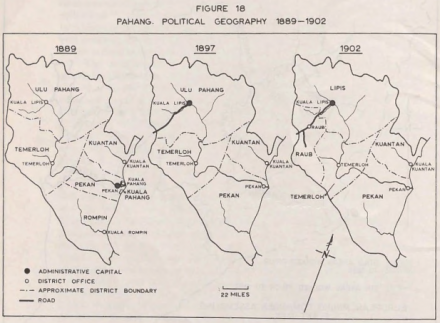
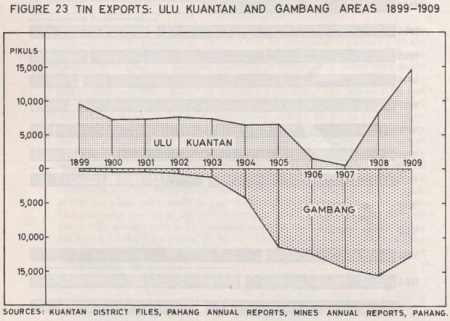
Kiri: Perubahan pusat pentadbiran dari Pekan ke Kuala Lipis (1889). Kanan: Kemerosotan Pahang Corporation @ Sg Lembing / Ulu Kuantan, dan Kegemilangan Loke Yew @ Gambang / Ulu Lepar (1904-1907).
(Sumber utama: Dr. R.G. Cant, 1973: |"An Historical Geography of Pahang" (PDF), m.s. 38-39, 48-50).
LATAR PERISTIWA: Sejarah Ibu Negeri Pahang
1906: Pahang Consolidated Company Limited
Pahang Corporation, Pahang-Kabang, dan beberapa syarikat (dan lombong) lain diambil alih oleh syarikat “Pahang Consolidated Company Limited”, yang ditubuhkan pada tahun yang sama. Kerja-kerja perlombongan dan pembangunan bermula pada tahun berikutnya (1907):-
“Pada bulan Julai 1906, pengurusan Lombong Sungai Lembing telah diambil alih oleh Pahang Consolidated Company Limited yang ditutup pada September 1986. Hasil bijih timah dari Gambang dibawa ke Kuantan melalui Sungai Belat di Gudang Rasau manakala hasil dari Sungai Lembing pula dibawa ke Pasir Kemudi dengan trak (kereta api) dan kemudiannya diangkut dengan kapal wap (belangkas) ke Kuantan untuk dieksport melalui Pelabuhan Kuantan.
Bagi memenuhi keperluan aktiviti ini, beberapa kawasan di pinggir Sungai Kuantan telah dimajukan sebagai pusat pengurusan dan pengumpulan bahan mentah, seperti bijih timah. Di antaranya ialah kemudahan pelabuhan, pejabat kastam, pejabat pentadbiran daerah, kedai dan sebagainya yang terletak di kawasan sekitar Jalan Besar, Jalan Mahkota dan Pinggir Sungai Kuantan.
Dengan corak pembangunan ini, kawasan bandar mula didiami oleh orang-orang Cina, sementara orang Melayu yang mula membuka penempatan awal di tebing Sungai Kuantan telah berpindah ke kawasan pinggir bandar, seperti di Padang Lalang, Tanjung Lumpur, Beserah, TANAH PUTIH, dan sebagainya.”
(Sumber: roshanilawatey, 2010: |"Sejarah Kuantan (2) : Pusat Pengumpulan Hasil Bijih Timah").
(Kemungkinan antara sumber asal: Alias Abdullah, Jabatan Perancang MPK dan Fauziah binti Zakaria, |"Pahang Dalam Sejarah, Bil.4, Tahun 1989", m.s.1: Sejarah Pembukaan Kuantan (1850-1970)).
“While the new administration established tighter regulations for mining operations, it was forced to recognize the initial 77 year concession over 200 square miles. Development work and the low prices of the 1890s prevented much production but by 1906 the whole property was being exploited by Pahang Consolidated which would become one of the world’s largest lode mines.” (John Hillman, 2010: |"The International Tin Cartel" (PDF), m.s.34)
“By 1904 the Pahang Kabang Company had ceased work and the Pahang Corporation was heavily in debt to the Borneo Company which acted as its Singapore agent. An outside geologist was called in and, on the basis of his favourable report, it was decided to combine the companies, increase their capital, and reorganise mining on a larger scale. In 1906 the existing companies were wound up and the Pahang Consolidated Company, with a capital of £250,000 was formed. New plans for the development of the mines were prepared, equipment was ordered from Europe, and the construction of a light railway from Sungei Lembing to Kuala Reman was undertaken. After a period of careful prospecting and construction work, mining was recommenced in 1907. By 1909 output had again reached the peak level of the former decade (fig. 21 ). At the end of that year the Company employed 1,600 miners and contributed
one third of the tin exported from Pahang. In its expanded form the Pahang Consolidated Company was able to achieve economy of scale without any parallel investment by the Pahang administration.
The most important changes which took place in the geography of Pahang during the first two decades of British administration were directly or indirectly associated with mining. The areas of greatest population increase and urban development were the mining districts of Kuantan and Ulu Pahang, and the pace of development, as measured by the increase of trade and productivity, was largely controlled by the state of the mining industry and government
policy with respect to road construction. The mining industry, however, was never established on a large enough scale to meet the revenue needs of the whole State. At no time did the mining revenue received by the Pahang
government exceed five per cent of that for the Federated Malay States as a whole. It became increasingly clear that the mineral resources of Pahang were on a less liberal scale than those of Perak and Selangor, and, if the value of its mineral wealth was to be the index of its prosperity, then Pahang must inevitably lag behind its western neighbours. By 1909 it was widely realised that the future development of Pahang did not lie in its mineral resources. Tin was the major source of its revenue but the price for this was falling off and the alluvial tin fields already showed signs of exhaustion.”
(Sumber utama: Dr. R.G. Cant, 1973: |"An Historical Geography of Pahang" (PDF), m.s. 53-54).
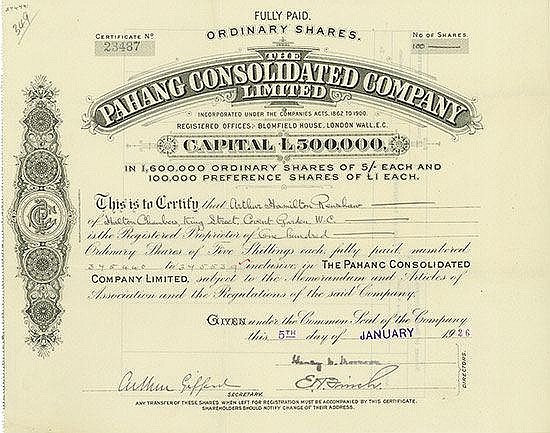
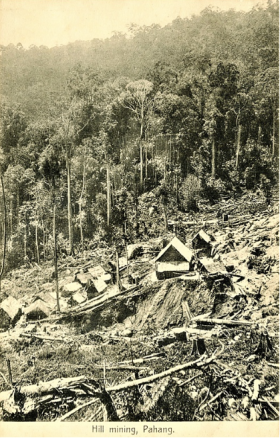
Kiri: Sijil Syer Pahang Consolidated Company Limited (HWPH Historisches Wertpapierhaus AG, 2015: |"Lot 899: Pahang Consolidated Company Limited").
Kanan: “View of the Pahang placer tin mining area, ca. 1910.” (Sumber: Mindat.org: |"Kuantan District, Pahang, Malaysia").
Suatu perbincangan menarik berkenaan sejarah Pahang Consolidated Company Limited: Mine Exploration & Mining History - Mine Exploration Forum, 2011-2019: |"British Miners in Malaya 1888-1915".
1908-1910: Pembinaan Jalan dan Perkhidmatan Feri
“Dalam tahun 1908, Jalan Kuantan – Gambang sejauh 18 ½ batu (30 km) telah disiapkan. Walau bagaimanapun, kenderaan-kenderaan perlu menyeberangi Sungai Kuantan di TANAH PUTIH dengan menggunakan feri yang telah dibuka pada 5 September 1910. Dengan terbukanya jalan ini, Gudang Rasau telah ditinggalkan dan Kuantan mula diperluaskan. Perhubungan dari Sungai Kuantan pula dikendalikan oleh Syarikat PCCL yang menyediakan perkhidmatan pengangkutan trak dan kereta api dari Sungai Lembing ke Pasir Kemudi dan kemudiannya belayar dengan menggunakan kapal wap ke Pelabuhan Kuantan. Pelabuhan Kuantan ini dibuka pada awal tahun 1900 dan dipindahkan ke Tanjung Gelang pada tahun 1970-an.” (roshanilawatey, 29 Jun 2010: |"Sejarah Kuantan (4) : Sistem Perhubungan & Pengangkutan"). (Kemungkinan antara sumber asal: Alias Abdullah, Jabatan Perancang MPK dan Fauziah binti Zakaria, |"Pahang Dalam Sejarah, Bil.4, Tahun 1989", m.s.1: Sejarah Pembukaan Kuantan (1850-1970)).
1913-08-01: Penubuhan Kuantan Sanitary Board
“Melalui Warta Kerajaan Pahang Bil. 2167 bertarikh 1 Ogos 1913, telah ditubuhkan bertanggungjawab terhadap kawalan kebersihan, kesihatan dan pembangunan di dalam kawasan pentadbirannya dengan jawatan pengerusi “Kuantan Sanitary Board” pada masa itu disandang oleh Pegawai Daerah sendiri.” (roshanilawatey, 29 Jun 2010: |"Sejarah Kuantan (3) : Pemodenan dan Perubahan Dasar Pentadbiran"). (Kemungkinan antara sumber asal: Alias Abdullah, Jabatan Perancang MPK dan Fauziah binti Zakaria, |"Pahang Dalam Sejarah, Bil.4, Tahun 1989", m.s.1: Sejarah Pembukaan Kuantan (1850-1970)).
1918-11: Pembukaan Jalan Kuantan-Jerantut-Kuala Lipis
“Pada bulan November 1918, jalan raya dari Kuantan ke Kuala Lipis melalui Jerantut telah disiapkan. Siapnya jalan tersebut bermakna memudahkan perhubungan Kuantan dengan kawasan Pantai Barat. Sebelum itu, pegawai-pegawai dan orang-orang di Ulu Pahang yang hendak ke Kuantan terpaksa menghilir Sungai Pahang dengan menggunakan perahu atau rakit ke Pekan. Kemudian berjalan dari sana ikut pantai laut ke Singapura dan juga ke Kuantan.
'Perjalanan dari Kuantan ke Kuala Pahang, selama 8 bulan dalam setahun dilakukan dengan menggunakan perahu jalak yang boleh memuatkan dua belas orang dan barang-barang hingga 15 tan dengan bayaran $25.00 bagi sehala perjalanan. Kapal kecil digunakan untuk pergi ke Singapura (Lihat Sejarah Pahang PSCP)…'.”
(Sumber: roshanilawatey, 29 Jun 2010: |"Sejarah Kuantan (4) : Sistem Perhubungan & Pengangkutan").
(Kemungkinan antara sumber asal: Alias Abdullah, Jabatan Perancang MPK dan Fauziah binti Zakaria, |"Pahang Dalam Sejarah, Bil.4, Tahun 1989", m.s.1: Sejarah Pembukaan Kuantan (1850-1970)).
Suasana Perlombongan Sekitar 1920-an
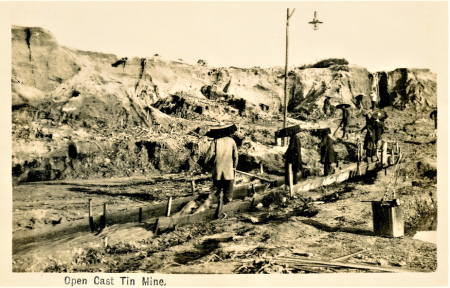

Kiri: “View of the Pahang placer tin mining area, ca. 1920.”
Kanan: “View of the Pahang placer tin mining area, ca. 1920.”
(Sumber: Mindat.org: |"Kuantan District, Pahang, Malaysia").
Peta Kuantan 1928
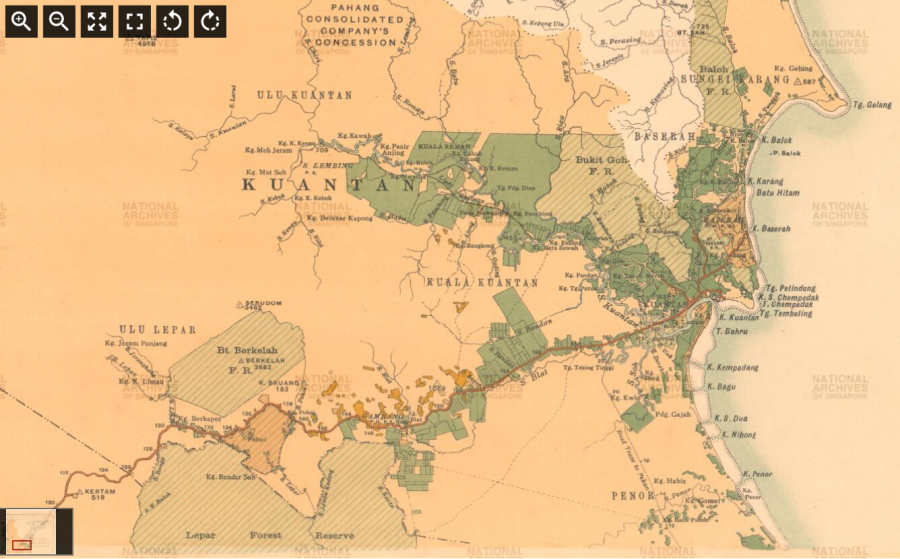
Kawasan konsesi Pahang Consolidated Company Limited, di sebelah utara peta Kuantan 1928 (Survey Department, Singapore; 测量局; Singapore. Survey Department, 1928: |"Pahang,1928").
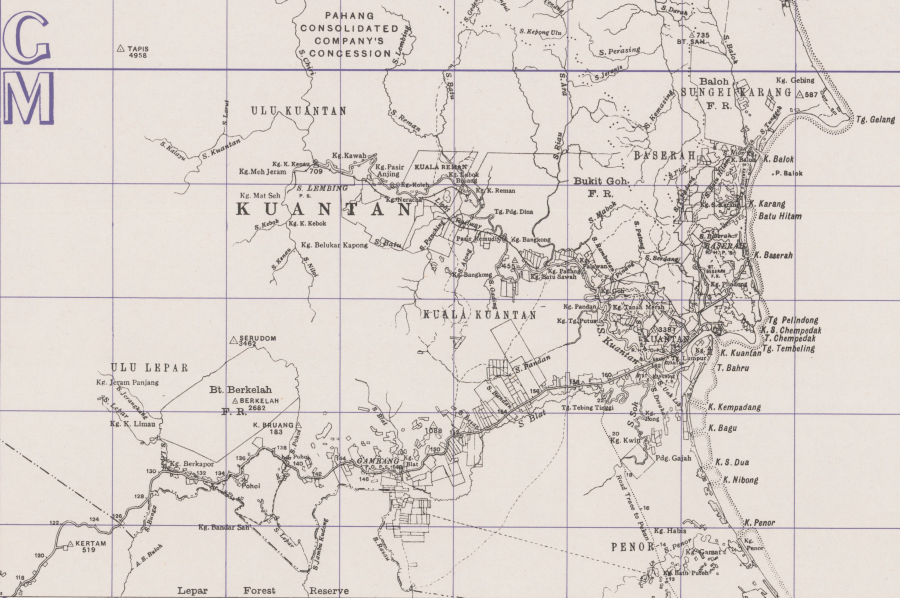
Kawasan konsesi Pahang Consolidated Company Limited, di sebelah utara peta Kuantan 1928 (salinan tahun 1942-1943): “Copied from a map published by the F. M. S. & S. S. Survey dept. 1928.” (Great Britain. War Office. General Staff. Geographical Section, 1942-1943: |"Pahang, 1928").
1933: Pembukaan Jalan Pekan-Kuantan
“Berikutnya, rangkaian jalan raya dari Pekan ke Kuantan (di Bt. 6 Jalan Gambang, sejauh 30 batu @ 48km) pula dibuka pada tahun 1933.” (roshanilawatey, 29 Jun 2010: |"Sejarah Kuantan (4) : Sistem Perhubungan & Pengangkutan"). (Kemungkinan antara sumber asal: Alias Abdullah, Jabatan Perancang MPK dan Fauziah binti Zakaria, |"Pahang Dalam Sejarah, Bil.4, Tahun 1989", m.s.1: Sejarah Pembukaan Kuantan (1850-1970)).
Taburan Kawasan Bijih Timah (Setakat 1940)
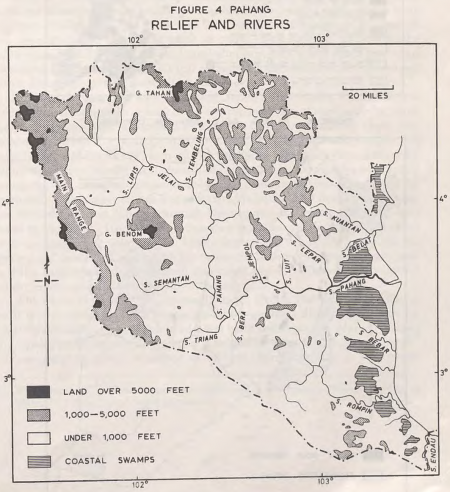
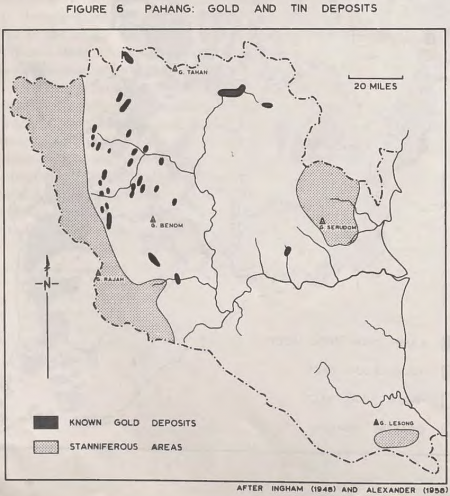
Kiri: “FIGURE 4 PAHANG RELIEF AND RIVERS”
Kanan: “FIGURE 6 PAHANG: GOLD AND TIN DEPOSITS”
“Pahang, in common with adjoining States of the Malay Peninsula, has mineral deposits which have Long attracted the attention of miners and traders. The present discussion is confined to minerals discovered prior to 1940. Tin has been found in three main areas of the State; firstly on the eastern slopes and margins of the Main Range; secondly on the flanks of Gunong Serudom in the Kuantan District; thirdly in the south of the State, in the vicinity of Gunong Lesong (fig. 6). Small quantities of gold have been discovered in many Localities, mainly within a broad belt known as the Malayan Gold Belt which extends from Mount Ophir in Johore, through Pahang into Kelantan, and north into Patani in Thailand. Iron ore exists in a number of places; in prehistoric times it was smelted in the valley of the Tembeling and in the 1930's large reserves were proved in south Pahang. Other minerals, such as copper, wolfram, and scheelite, have been mined in small quantities but they have never been important in the overall development of Pahang.” (Dr. R.G. Cant, 1973: |"An Historical Geography of Pahang" (PDF), m.s. 11).


